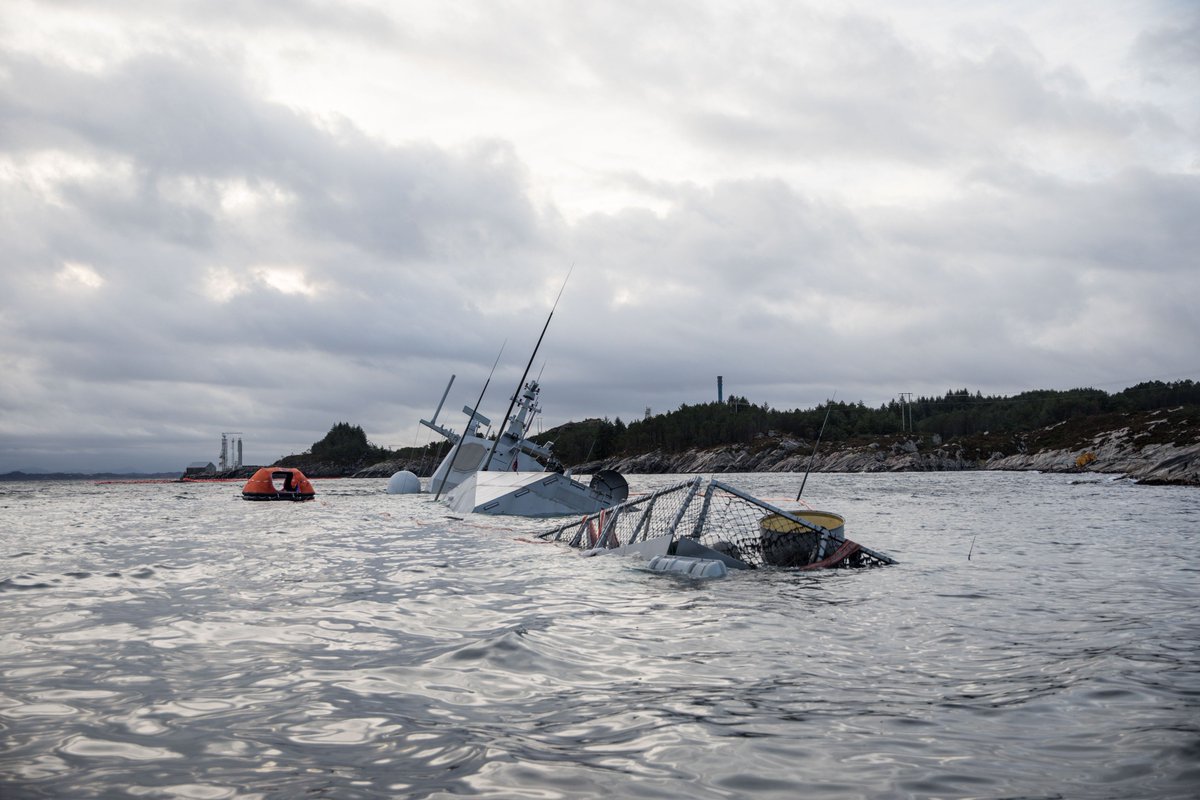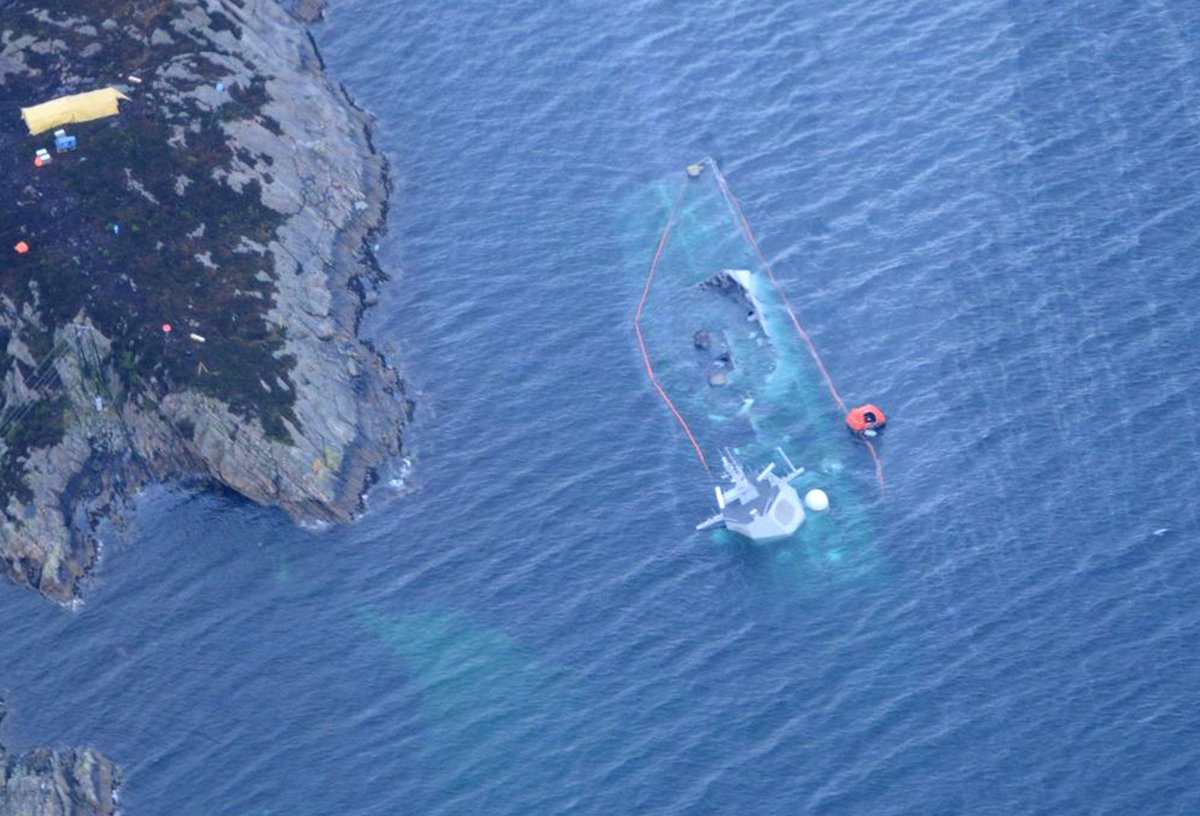Dizasta1
Senior Member
what the hell was a commercial oil tanker doing right in the middle of a full blown NATO exercise?
this was not a small frigate it was over 5,000 tons a very expensive
That, my dear brother, is a very good question!!
what the hell was a commercial oil tanker doing right in the middle of a full blown NATO exercise?
this was not a small frigate it was over 5,000 tons a very expensive
so why on Earth do youAs always, people start making jokes of of other's disgraces….
I supose has been photoshoped but I don't find it funny.
Accidents happen and we should not mock other's disgraces. People could have died in this accident.
what the hell was a commercial oil tanker doing right in the middle of a full blown NATO exercise?
this was not a small frigate it was over 5,000 tons a very expensive
Probably delivering crude oil to the port...
Now this!...follow the link below for the full story in the headline.
By PAUL SONNE, DAN LAMOTHE | The Washington Post | Published: November 17, 2018
The U.S. Navy expects one of its officers to be questioned as part of an investigation into the collision of a Norwegian warship and a commercial oil tanker this month in one of the Scandinavian nation's fjords.
The American officer, who has not been identified, was onboard the Norwegian navy frigate as part of a military personnel exchange, according to U.S. and Norwegian officials. The sailor's role on the ship remains unclear.
The Nov. 8 incident ultimately sank the 439-foot Norwegian warship and left several people injured.
Norwegian naval officers beached the vessel - the KNM Helge Ingstad - in an attempt to save it, but the frigate sank five days later after the cables holding it in place snapped. The tanker it struck, the Sola TS, was nearly twice its size at 820 feet. It suffered only minor damage.
"The U.S. Navy has an officer assigned to the Personnel Exchange Program (PEP) with Norway as part of the crew of the KNM Helge Ingstad," Cmdr. Kyle Raines, a spokesman for the U.S. Navy's 6th Fleet, said in a statement. "This program exchanges personnel from various military components to foreign countries to enhance interoperability with partner navies and services. The concept was born out of the need for partners and allies to share ideas and build relationships."
Raines declined to identify the American officer by name, citing privacy interests. He said the U.S. Navy is supporting the Norwegian investigation.
Traditionally, investigators interview all officers onboard military ships involved in collisions, so the U.S. Navy expects the American officer to be questioned as well, officials said.
Ann Kristin Salbuvik, an official at the Norwegian defense ministry, confirmed that an American officer was onboard the ship but declined to specify the officer's duties.
It is standard procedure as the investigation team will of course question ALL of those on board the ship anyway.Depends on what his role was or where he was on the frigate. If he was on the bridge when the collision occured then they would likely invite him over for 'tea'.
It is standard procedure as the investigation team will of course question ALL of those on board the ship anyway.
and the story goes on as Early report blames confused watchstanders, possible design flaws for Norway’s sunken frigatenow the story is
hopes to raise sunken INGSTAD in 3 weeks, place the damaged ship on a barge and get her to Haakonsvern naval base near Bergen for evaluation. A "very demanding" salvage challenge at that rate.


perhaps the most interesting isNorway’s accident investigation board is raising questions about the watertight integrity of the Nansen-class frigates and is pointing its finger at shipbuilder Navantia in the wake of the collision and subsequent in early November.
In a preliminary report released Thursday, the board reached an initial conclusion that during watch turnover was the proximate cause of the accident, but the sinking of the ship was caused by progressive flooding that appeared to overmatch Ingstad’s watertight integrity.
The Accident Investigation Board Norway, or AIBN, issued a public addendum to the report and a pair of warnings that the issues that sunk Ingstad could also apply to other Navantia ships, raising questions about a widespread quality issue at the Spanish shipbuilder.
“The AIBN has found safety critical issues relating to the vessel’s watertight compartments,” the report reads. “This must be assumed to also apply to the other four Nansen-class frigates.
“It cannot be excluded that the same applies to vessels of a similar design delivered by Navantia, or that the design concept continues to be used for similar vessel models. The AIBN assumes that its findings are not in conformity with the required damage stability standard for the Nansen-class frigates.”
In a statement to Defense News, Navantia spokesperson Esther Benito Lope stressed that the report is “very preliminary” and that the company has offered to work with Norway on the investigation.
“Navantia has offered, since the very beginning, its collaboration with the [Royal Norwegian Navy] in order to clarify the accident,” Benito Lope said. “Navantia will analyze all the possibilities, considering that some of the mentioned possibilities … are concluded from a very preliminary investigation.”
The statement went on to say that the company has not received any official notice or fielded any consultations about the cause of the accident.
“Navantia has not received any official communication, neither any consults about possible causes, nor participated in any action … in Norway,” Benito Lope wrote.
Progressive flooding
In the addendum to the report, the board found that the initial assessment by the crew in the wake of the accident was that some crew quarters, the aft generator room and the ship’s stores room were flooded, but that the ship was stable and could survive if the situation remained relatively controlled.
But then it didn’t.
The crew began seeing water quickly flooding into the gear room via the ship’s hollow propeller shaft, with flooding then creeping into the engine rooms through the bulkheads.
Propeller shafts have to pass through multiple engineering spaces through watertight openings in the wall known as stuffing tubes or stuffing boxes that are supposed to tighten down as water tries to get through, preventing progressive flooding.
The board’s initial assessment based on crew interviews is that the stuffing boxes did not work as designed on Ingstad.
“This meant that the flooding became substantially more extensive than indicated by the original damage,” the report reads. “Based on the flooding of the gear room, it was decided to prepare for evacuation.”
As a result of the findings, the AIBN issued two warnings: one to the Norwegian military to assess its ships to address the safety concerns, and one to Navantia to “conduct investigations into the issues identified during this initial investigation and to ascertain whether this is also an issue relating to other vessels.”
Confusion
Apart from the flooding that ultimately sank the Ingstad, the accident itself raises some vexing questions.
Ingstad collided with the Mata-flagged tanker Sola TS at around 4 a.m. in unlimited visibility just minutes after Sola had gotten underway from Norway’s Sture Terminal.
The report found that Ingstad was transiting the channel at about 17 knots well before dawn, faster than one might expect near a busy port at night. It also found that the collision took place about 10-15 minutes after a watch turnover.
The report concludes that Ingstad’s bridge watch team mistook Sola for an object on land, and that Sola’s illuminated deck lights obscured its navigation lights from view. Furthermore, even after the Sola got underway there would have been relatively little motion of Sola’s lights as it moved away from the quay.
In the last six minutes before the collision, Sola contacted Ingstad and instructed it to turn away from its course. Ingstad’s watchstanders thought they were communicating with one of the other ships in the channel, still thinking Sola was a stationary object, and said if they turned, they’d run into the object that turned out to be the rapidly closing tanker.
By the time Ingstad’s bridge team recognized the error and tried to evade Sola, it was too late, the report found.
“The AIBN's preliminary assessment is that the accident was not caused by any single act or event, but can be explained by a series of interacting complex factors and circumstances,” the report reads. “The investigation team is seeking to identify and understand these factors.
“So far, the AIBN has not seen any indication of technical systems not working as intended up until the time of the collision.”
More questions than answers
To retired Capt. Lawrence Brennan, a career U.S. Navy attorney and now an instructor at Fordham University’s School of Law, what’s interesting isn’t just what’s in the interim report but what was left out and will be explored later by other probes.
He pointed to the crew of the frigate Helge Ingstad and wondered what condition they had set the frigate to mitigate or prevent flooding.
He asked about the shift change on the bridge that seemed to coincide with the frigate entering waters bustling with commercial shipping in low visibility.
He indicated that more will be learned from engineers poring over the gash in the hull, which “seemed to be opened up like a can opener,” and interviews with crew members who can trace the quick decision-making process of a watch team that realized, like aviators, that its vessel had “put itself in a box” and faced increasingly bad options as danger loomed.
As for the AIBN’s twin interim safety recommendations to shipyards and Oslo’s military leaders, Brennan said that’s exactly what everyone should expect from an initial probe.
“We saw the exact same sort of investigations into s,” Brennan said.
